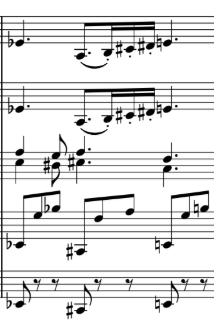All Activity
- Past hour
- Today
-
Yo Peter! Sorry I have been late to the party, due to laziness lol. Although I have listened to your excerpts tons of times, this is the first time I listen to a movement in full and with score. I must say, it sounds even more fascinating with a score at hand! I thoroughly enjoy this even though I have zero exposure to FF world, thx to my strict mum (time to blame your mum for a miserable childhood when you fail yourself in your real life lol!) I cannot and will not distinguish those 8 themes haha, just like Wanger's Leitmotifs which I can never remember their originals when they reappear at all lol. My most familiar theme is probably the Terra's theme because it usually starts a variation in imitation. I think this one really fits for a Scherzo. It sounds like an adventure and joyous wanderings but there is dark power underneath though not very apparent at the moment I guess. Btw, what are the short forms for the code of each of the 8 themes in the rehersal markings? The whole orchestration for me is fascinating and I will for sure steal something from here to my orchestration variations on your themes lol. lemme just take note of some spots I like: Beginning: I love all those imitations for the Terra Theme, it sounds like each team member is following the team's footstep into a journey to fxxk off the monster or final big boss, and the stretto treatment of the imitation gives excitement right at the beginning. The marching rhythm underneath with Timpani, Tuba, Cello and Double Bass is a pattern I should steal, though I may use add a bass drum to the snare drum as well. I also love both the Dorian C# and Phyrgian F natural in your themes as it really adds the folkore colour in the work. b.21 R Var.3: Love the very low register oboe, sounds dark to me. Since I'm also using harps in writing your variation, will you also follow the performance practice to the pedals the harp is using at the moment? You know what, I always get headached when I need to check whether the pedal notes of the harp is right. b.42 ES: Love the wind sextet setting, and then the string quartet plus horn setting. Sad the weird Musecore string sound sample which ruins the melody by always sliding ludicrously! b.72 FP Var.2: Love you start introducing the polyrhythm in flute in b.81, which will be used later for climax. Also, I really love the parallel fifth bass in b.89 as it sounds so prefectly disturbing! b.97 EA: I absolutely love the buildup here with both the tempo acceleration, tremolo, shorter and closer notes and more dissonances. I like the cilmax in b.117 esp. with the electric bass. Though, will it be great to add some brass here as well? It sounds a bit thin for a fff dynamic here for me personally. b.117 Scherzo beginning: I love the beginning. Though maybe for me I would also add a harp and a piano playing the low E here for that particular timbre, if there's not cost adding them haha. The new theme sound so peaceful, but the BD theme sounds greatly weird haha. I love the tremolo beneath and also your modulation to other keys here in b.170, since the music more or less stays in the tonal centre E for couple of minutes and it's the right time to add new things into it. And that G-Bb reinterpreted as G-A# to F#-B in flute, wow. b.180 L Var.3: Nice counterpoint between winds and horn themes even I forget where do the themes come from at all, and nice clash in b.183. b.196 FA: I really love the modulations here towards the hexatonic keys, they don't sound cliche as in many film music. The harmonic colour here is fascinating! Though, I may add a cresc. to ffffffff before the rests in b.207 and 211. b.218 AS Var.1: Nice relaxation! Nice imitation throughout as well. The polyrhythm from b.81 reappears as well. And that goddamn modulation to Db major in b.258!! It sounds so magical and refreshed after all those sharp key areas! But, it's so short!!!! And ruined immediately by the Kafka theme. Love the outburst of hextaonic G# minor and F minor at the end. It sounds unfinished which it should be for there are movements to follow. I remember Peter has an entire excel spreadsheet for all the themes he uses in each of the variation LoL!!!!!!!!!!!! Honestly I didn't remember any details in it due to my lazy nature lol. Very enjoyable! Looking forward to your other movements!! Henry
-
PeterthePapercomPoser started following Empty
-
therealAJGS started following Empty
-
Thanks Peter! I'm not familiar with Outlaw Star, but I have heard some of the music from cowboy bepop. As I recall some of the composers from the Shinobi games originally worked under Joe Hisaishi, who went on to score studio Ghibli films, and I've always kinda heard a bit of his influence in the games.
- Yesterday
-
Henry Ng Tsz Kiu started following Duet arrangement for Johannes Brahm's Intermezzo
-
Yes, that part is in fact Eb Lydian Dominant, otherwise known as the Acoustic scale since it contains all the first and most prominent harmonics of the harmonic series. Good eye/ear! This is the original material from the Mt. Kolts Theme: The scale used here is Eb Lydian #2 and is the sixth mode of the harmonic minor scale. Thanks for your interest!
-
PeterthePapercomPoser started following Volcanic Cavern
-
therealAJGS started following Volcanic Cavern
-
.thumb.png.8b5b433a341551e913a34392660bc95b.png)
My First Ensemble Piece Ever Recorded - Any Thoughts?
PeterthePapercomPoser replied to Mooravioli's topic in Chamber Music
Hey @Mooravioli! What an underwhelming piece to have as the first ensemble piece that you've had performed and recorded! I feel like your style is hard to get into, but it definitely gains from repeated listenings. The listener gains more and more affinity for this piece upon repeated listenings I mean. It's very esoteric to get into though. But I love your use of flutter-tongue and slap-tongue on the saxophone! Great use of extended techniques. Though I think that the music could be more unified and self-similar. I don't find myself whistling or humming a tune after listening to this piece. Besides just having cool techniques and unusual chords and progressions I think it's also important to give the listener a long-leading melodic line and a clear theme. But that might just be my opinion, and I'm a very thematic composer. You do you, of course. Thanks for sharing! -
.thumb.png.8b5b433a341551e913a34392660bc95b.png)
Duet arrangement for Johannes Brahm's Intermezzo
PeterthePapercomPoser replied to HoYin Cheung's topic in Chamber Music
Hello again @HoYin Cheung! First, I have to say that I love this piece! I've played it in recital back in my university days. I also love the idea of arranging this for a solo Violin - Piano duet! It will definitely make for some very musically intimate moments between you and your g/f that only this kind of music can create! I do have a minor critique of your arrangement however - I feel like the Violin and Piano should start together, doubling the main melody at the same time. I think it sounds like something is missing when the piano starts alone, without the Violin and it's also too much like the original. I think you should endeavor to make your arrangement different from the original from the very beginning, to make potential listeners aware that this is an arranged version from the very beginning. That's my humble opinion. Every other part of the arrangement is great! Thanks for sharing! -
PeterthePapercomPoser started following Duet arrangement for Johannes Brahm's Intermezzo
-
Hey @Mooravioli! Thanks for your review! Stay tuned for that in a future movement! I've already composed a variation which does this, I just haven't integrated it into a finished movement yet. I feel like it wouldn't be in the spirit of the original themes by Nobuo Uematsu to use microtones since they didn't use microtones. Although I definitely plan on writing plenty of my own microtonal VGM music in the future. Thanks again for your review!
-
shirz started following This song took me 2 months, here's what happened.
-
This song took me 2 months, here's what happened.
shirz replied to therealAJGS's topic in Incidental Music and Soundtracks
Sounds awesome! Really like how all the instruments sound together. The timing of the notes gives a feeling of slipping and unpredictability. I imagine this would fit in a game where you need to move carefully to make you feel unstable. Or simply a horror game full of surprises. -
Mooravioli started following Symphonic Fantasy on 8 Themes from Final Fantasy VI - Scherzo
-
Hello Peter, A masterful work which integrates many unique and lovely textures, as well as colorful dissonances. I especially liked the string quartet variation, which I thought was quite original of you to include. Although the piece remains in e minor for much of its duration(apart from the later variations), I feel there are so many distinguishing features in the compositional process that shift the focus away from modulation, and I must say that this is not easy to do(as a composer who relies too much on modulation). With this, you are building a really interesting, modal harmonic language. I also admire the way you've woven the different themes together to create a rich, dense texture. I do think it would be a nice contrast if we could have a clear melodic line/homophonic idea in order to introduce a specific theme. Hey.. its just an idea. But I am also surprised you're not using microtones in this piece because to me, its probably a part of your style at this point. 🥴
-
HoYin Cheung started following Duet arrangement for Johannes Brahm's Intermezzo
-
Dear all, After all recent completion of my Symphony No.1 - Movement II, I finally got some time to work on some tiny projects. Phew. This time I would like to present my arrangement for Johannes Brahm's Intermezzo. The original work by Johanne Brahms is written for piano solo. It is definitely perfect and is one of my (and my gf's) favourite classical works. My gf and I want to plat it in arrangement for violin-piano duet, but the available scores online, in my humble opinion, does not build enough interaction between the violin and piano. Therefore, I decided to make my own arrangement for this piece. Minimal modification was made in terms of additional elements/ chord changes. Main features in this version includes the further emphasis of the "longing" motive ("C-B-D") and distribute the melodic part more evenly between the instruments. I also added some harmonics for violin to bring in some extra variety of texture for the piece. Hope it sounds well. Please feel free to share your thoughts on this arrangement. Thank you! Best, HoYin
- 1 reply
-
- 1
-

-
Avétis joined the community
-
ComposaBoi started following 2 Choral Motets
-
I believe you're referring to beat 3? I didn't want to spell the Eb major chord as a D# major chord (on account of having to spell the G as an Fx and also because there occur both F#'s as well as G's in the voice leading which are still best understood in the key of E minor). The chord on beat 3 is actually an F# major chord spelled with a Bb instead of an A# (and again, this is done because of voice leading since the Bb leads to an A in the following harmony of B7 with a C# in the bass). You gotta consider that the whole chromatic system is imperfect and often, compromises must be made for the sake of readability and voice leading. Also often, organizing the given pitches into a heptatonic scale with no repeated notes as best one can takes precedence over spelling passing chords on weak beats correctly. Are you referring to the Db major section in measure 258? Db major has 5 flats while C# major has 7 sharps so that was just a practicality and familiarity thing. Some key signatures are preferable to others for practical reasons and are used way more often because of that. That to me justified switching to a flat key even though the tonal center of C# is not that foreign to a piece in E minor, being the relative minor of E major. Yes, that is annoying for sure. Even more so for harp which sometimes needs everything respelled a certain way according to the position of its pedals. But correct me if I'm wrong, but you seem to use scores in concert pitch for your music? That's one way to avoid the trouble in the score, but if you ever need to print out parts you'd still need to transpose it to the correct enharmonic key. Unless you're working with an instrumentalist who is expected to be able to transpose such as Trumpet or French Horn. Thanks for your comments!
- Last week
-
Could be for a game or a movie idk. maybe this fits more in a movie. This is in piano but I hope you can imagine it as an orchestral cinematic piece like I do. Just not really experienced in arranging orchestral intruments. Maybe Ill do it in the future. I think this is considered a scottish or irish style correct me if i'm wrong. Would love to hear your thoughts. https://on.soundcloud.com/8rUORnL2KJFhPd1P1h The mistakes in the start are intentional.
-
Thank so much for the warm, kind review.
-
I notice some interesting enharmonic spelling choices. E.g. Bar 32, you've got a Bb minor triad between the celli and violas, spelled with a C# instead of a Db. Then in some places you have lots of flats, and I think you're changing mode here, rather than moving to a different diatonic key? Wondered if it was difficult to choose which spelling to use? Sometimes when my music gets very chromatic, I find I need different spelling in the transposing instruments, which is an added complication! Seems to apply especially to Bb instruments, like clarinet and trumpet.
-
Rhapsody for Symphony Orchestra
Marc Deflin replied to A Ko's topic in Orchestral and Large Ensemble
Very nice work, sounds huge 🙂 Which soundbank(s) do you use ? -
Hi all 🙂 On vacation doing little treks in the eastern Vosges mountains in France, I profited by my late afternoon free times to give a first try at a woodwind quartet. Here's the result study. I merely structured it as A B ... A B 🙂 and there are one or two harmonic attempts in it. Regards




.thumb.png.f5c7c1a6a554eeeefdce321d089f5901.png)






